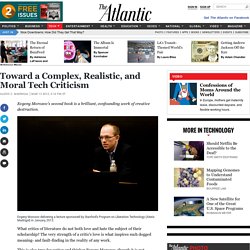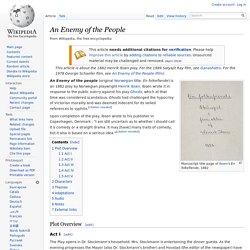

Amazon. Amazon. Your Brain at Work: Strategies for Overcoming Distraction, Regaining Focus, and Working Smarter All Day Long: David Rock: 9780061771293: Amazon.com: Books. The Grantchester Mysteries, by James Runcie. Tales of the Dervishes: Teaching Stories of the Sufi Masters Over the Past ... - Idries Shah. The Observing Self: Mysticism and Psychotherapy - Arthur J. Deikman. How Would Nature Design A Company? BioInspired Business Book by Dr. Tamsin Woolley-Barker. Toward a Complex, Realistic, and Moral Tech Criticism — The Atlantic. Evgeny Morozov's second book is a brilliant, confounding work of creative destruction.

Evgeny Morozov delivering a lecture sponsored by Stanford's Program on Liberation Technology (Alexis Madrigal) in January, 2013. What critics of literature do not both love and hate the subject of their scholarship? The very strength of a critic's love is what inspires such dogged meaning- and fault-finding in the reality of any work. This is also true for writer and thinker Evgeny Morozov, though it is not literature but technology that must bear the privilege of his evisceration. Selfish, Shallow, and Self-Absorbed: Sixteen Writers on Their Decision Not To Have Kids by Meghan Daum. Cool: How the Brain’s Hidden Quest for Cool Drives Our Economy and Shapes Our World. Toward a Complex, Realistic, and Moral Tech Criticism - Alexis C. Madrigal. An Error Occurred Setting Your User Cookie. An Enemy of the People.
Manuscript title page of Ibsen's En folkefiende, 1882 Upon completion of the play, Ibsen wrote to his publisher in Copenhagen, Denmark : "I am still uncertain as to whether I should call it a comedy or a straight drama.

It may [have] many traits of comedy, but it also is based on a serious idea. "[citation needed] Plot Overview[edit] Act I[edit] The Play opens in Dr. Act II[edit] The next morning in Dr. Maybe Someday. Well Read. Poiemaeia. Bibliotheke. Plume. Libraries. Book: Shamanism for the Age of Science by Kenneth Smith. Additional Information & Updates Shamanism for the Age of Science by Kenneth Smith (Bear & Co., 2011), begins the work of bridging science and modern Toltec shamanism, offering a valuable reference for the research, discovery, and application of knowledge relating to the human energy body.

The following information provides a better understanding of the book itself and offers more context for selected topics. An Introduction This book is a work of philosophy and science, or of consciousness and science. The marketing category "Spirituality/New Science" may therefore seem a bit odd. Homeopathy (page 16) In general terms, a homeopathic remedy is diluted several times often to remove physical traces of the molecule An energetic imprint of the molecule produced through vigorous shaking or succussing is thought to remain.
Validated studies (page 83) A more accurate term for "validated animal model" is "recognized model. " Entanglement (page 163) Epilogue (page 251) Angel Tech A Modern Shaman's Guide To Reality Selection by Antero Alli Preface by Robert Anton Wilson. The Woman Who Read Too Much: A Novel. Gossip was rife in the capital about the poetess of Qazvin.

Some claimed she had been arrested for masterminding the murder of the grand Mullah, her uncle. Others echoed her words, and passed her poems from hand to hand. Everyone spoke of her beauty, and her dazzling intelligence. But most alarming to the Shah and the court was how the poetess could read. #24. A Summary of ‘Thinking, Fast and Slow’ by Daniel Kahneman. ‘Thinking, Fast and Slow’ by Daniel Kahneman (Farrar, Straus and Giroux; October 25, 2011) Table of Contents: i.

Introduction/Synopsis Section 1: An Introduction to Thought, Fast and Slow 1. Psychology_Today_Louder_Than_Words.pdf. If Ignorance Is Bliss, Why Aren't There More Happy People?: Smart Quotes for ... - John Lloyd, John Mitchinson. Cosmic Numbers: The Numbers That Define Our Universe. A mathematics professor delves into the fundamental numbers of our universe.

Review by Linda P. Rothschild Cosmic numbers are those constants that are intrinsically connected to the physical laws of our universe. Not all numbers that are associated with the natural world are “cosmic” in this sense. Analytic Thinking. Author: Linda Elder and Richard Paul Publisher: Foundation for Critical Thinking Copyright: 2010 Pages: 48 Dimensions: 51/4" x 8" ISBN (10Digit): 0-944583-19-9 ISBN (13Digit): 978-0-944583-19-7 Kindle Version.

The Structure and Dynamics of Networks: - Mark Newman, Albert-Laszlo Barabasi, Duncan J. Watts - Google Books. Intelligent Systems: Principles, Paradigms and Pragmatics - Robert J. Schalkoff. The Yale Book of Quotations: Fred R. Shapiro, Joseph Epstein: 9780300107982: Amazon.com: Books. Qualitative Complexity: Ecology, Cognitive Processes and the Re-Emergence of ... - John Smith, Chris Jenks. The Fellowship: The Untold Story of Frank Lloyd Wright and the Taliesin Fellowship (9780060393885): Roger Friedland, Harold Zellman.
Eat, Pray, Love" by Elizabeth Gilbert. Introduction or How This Book Works or The 109th Bead When you're traveling in India--especially through holy sites and Ashrams--you see a lot of people wearing beads around their necks.

You also see a lot of old photographs of naked, skinny and intimidating Yogis (or sometimes even plump, kindly and radiant Yogis) wearing beads, too. These strings of beads are called japa malas. They have been used in India for centuries to assist devout Hindus and Buddhists in staying focused during prayerful medita- tion. The necklace is held in one hand and fingered in a circle--one bead touched for every repetition of mantra. The Worlds Weirdest Book.
A truly unique work of fiction, ‘The Codex Seraphinianus‘ is a book that appears to be a visual encyclopedia of some unknown world or dimension.

Utopia by Thomas More. Rabelais: Gargantua and Pantagruel, Five Volumes, Complete. Idril's Fantasy. The Rubáiyát of Omar Khayyám, as translated by Edward FitzGerald, was first published in 1859 and subsequently illustrated more times perhaps than any other book.

Illustrated editions flourished particularly in the earlier 20th century. An edition of the Rubáiyát frequently involves not just random illustrations here and there, but lavish decorative features, often including an entire book design by the artist. So here is a little taster of some of the nicest illustrators of the poem that I’ve found… Edmund Dulac (1882-1953) Ebook, An Enquiry Concerning Human Understanding, by David Hume. Ebook, The Communist Manifesto, by Karl Marx. Ebook, Studies in Pessimism Arthur Schopenhauer. Ebook, Beyond Good and Evil, by Friedrich Nietzsche. Ebook, Pragmatism, by William James. Ebook, Parents and Children, by George Bernard Shaw. The Project Gutenberg E-text of The Will to Believe, by William James. From Eternity to Here: The Quest for the Ultimate Theory of Time, by Sean Carroll. The Book • The Author • Contents • Commentary • Excerpts • Extras • Book Club • Errata • Interactions • Contact About the book Why do we remember the past, but not the future?
Why don't we meet people who grow younger as they age? Why do things, left by themselves, tend to become messier and more chaotic? What would Maxwell's Demon say to a Boltzmann Brain? The answers can be traced to the moment of the Big Bang -- or possibly before. Time pervades our lives -- we keep track of it, lament its loss, put it to good use.
The arrow of time is easy to perceive, much harder to understand.